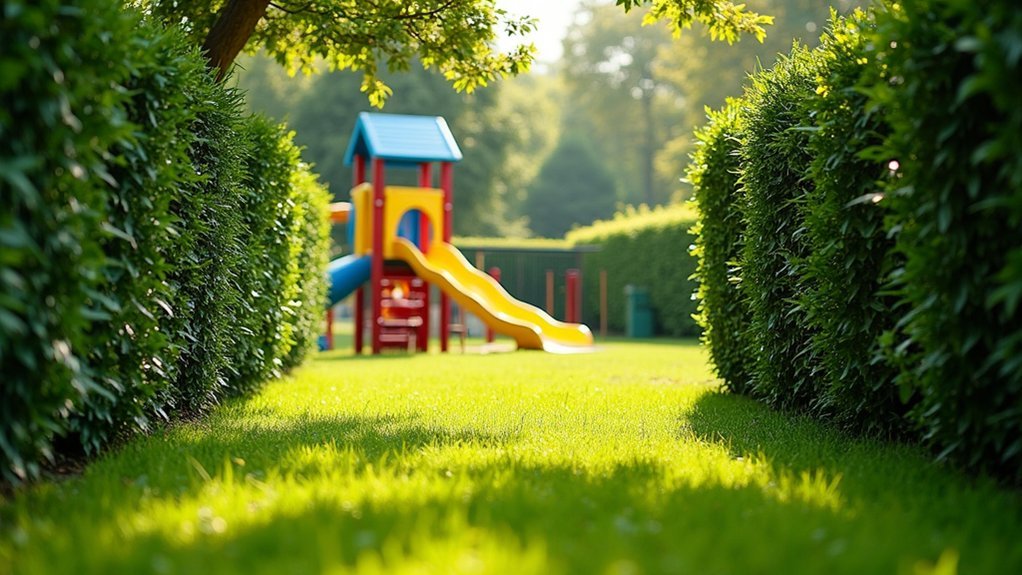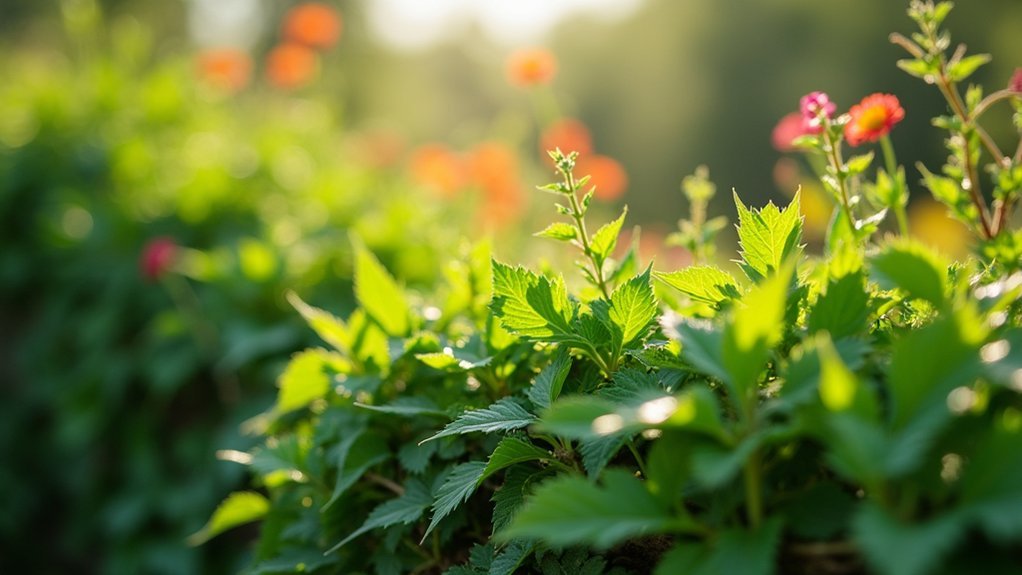No truly thorny hedge is completely safe for kids, but you can create child-friendly security with alternatives like Green Mountain Boxwood, Arborvitae, Glossy Abelia, and Pittosporum. If you must keep existing thorny plants, establish 5-10 foot buffer zones between play areas and hedges, and install clear boundaries with small fencing or mesh. Regular seasonal maintenance helps minimize hazards while preserving security benefits. Discover how to balance your home’s protection needs with your family’s safety below.
Understanding the Safety Risks of Traditional Thorny Hedges

When creating a child-friendly garden, thorny hedges present significant safety challenges that shouldn’t be overlooked.
Traditional options like rose hedges and pyracantha can cause painful scratches, cuts, and puncture wounds if children fall into them or touch them carelessly.
Sharp-stemmed hedges like roses and pyracantha pose real danger to children, who may suffer serious injuries from accidental contact.
Beyond the immediate risk of physical injury, some thorny plants contain toxic sap that poses additional dangers. Yew hedges, while excellent for privacy, contain toxic components that are hazardous if ingested by curious children.
Regular assessment of your garden space is essential for identifying these potential hazards. Recent research shows children display innate caution toward potentially harmful plants, though this natural hesitation may not be sufficient protection.
If you’re considering thorny hedges, remember that proper supervision, protective clothing, and teaching children about plant dangers are vital precautions.
Always have a first aid kit nearby and know how to respond to thorn-related injuries.
Child-Friendly Alternatives to Thorny Security Plants
Despite the security benefits of thorny hedges, your family garden doesn’t need sharp deterrents to maintain safety and privacy. Several thorn-free options provide excellent security while keeping your children safe during outdoor play.
Consider these child-friendly alternatives:
- Green Mountain Boxwood and Arborvitae – These create dense, impenetrable barriers without thorns, offering privacy and boundary definition with soft foliage children can safely touch. Safety of plants is crucial when designing outdoor spaces for families with children and pets.
- Glossy Abelia and Pittosporum – Both provide attractive flowering options that maintain security without harmful thorns, adding visual appeal to your garden perimeter.
- Edible Pineapple Guava – This unique hedge offers the dual benefits of security and edible fruits, turning your protective barrier into a functional food source.
These alternatives require minimal maintenance while providing the security you need without safety concerns.
Creating Safe Buffer Zones Between Play Areas and Defensive Hedges

While thorny hedges provide excellent security for your property, they must be strategically separated from children’s play areas to prevent injuries.
Establish buffer zones of 5-10 feet between play spaces and thorny plants to guarantee adequate clearance.
Safety demands space – maintain 5-10 foot clearance between thorny barriers and children’s play areas.
Install physical barriers like low fencing or soft nylon mesh to create clear boundaries. Add clear warning signs to deter curious children and pets from venturing too close.
For ground surfaces within buffer zones, consider soft ground covers like creeping juniper or safety tiles that prevent slips while maintaining distance from thorny plants. Plants like Teton Firethorn can provide excellent security with their sharp thorns while maintaining an attractive appearance.
Enhance visibility with adequate lighting around buffer areas, especially for nighttime safety.
You can also incorporate visual distractions through mixed landscaping with varying heights and non-toxic plants that screen the defensive hedge from view while maintaining its security benefits.
Seasonal Maintenance to Reduce Safety Hazards
Maintaining your thorny hedges throughout the year isn’t just about aesthetics—it’s an essential safety practice when children are present on your property. Regular seasonal pruning considerably reduces hazards while preserving your hedge’s protective benefits.
Start with a thorough spring inspection after winter damage, removing loose thorns and overgrown sections that could harm curious children. Since you have small children who might run through gaps into the neighbor’s yard, ensuring thorns are properly trimmed is particularly important.
Summer maintenance keeps paths clear and prevents unexpected scratches during outdoor play.
- Spring cleanup – Remove dead branches, loose thorns, and winter debris that create hidden dangers
- Summer trimming – Cut back any branches extending into walkways where children might run or play
- Fall preparation – Clear fallen leaves and debris that might hide thorns or sharp edges before winter sets in
Don’t forget to wear protective gear during all maintenance tasks.
Balancing Home Security Needs With Child Safety

Creating a secure home environment that deters intruders shouldn’t come at the expense of your children’s safety. Instead, implement layered landscaping by placing thorny plants behind soft groundcover borders and in front of taller hedges. This creates natural security zones while keeping play areas protected.
Choose non-toxic varieties like Teton Firethorn that won’t cause harm if accidentally ingested. Select plants with thorns positioned above typical child-reach height, and maintain hedges under 4ft near play spaces to prevent climbing accidents. Consider roses with beautiful blooms that enhance your landscape aesthetics while providing thorny stems for defense.
Install small barriers between thorny perimeters and child-accessible areas, and use strategic planting to maintain clear sightlines for supervision.
For walkways, consider gentle deterrents like creeping raspberry that discourage straying without causing serious injury if encountered.
Legal and Ethical Considerations for Family-Friendly Hedge Selection
Homeowners must navigate a complex web of legal and ethical considerations when selecting thorny hedges that balance security with family safety.
Before planting, check your local zoning laws regarding hedge height restrictions and verify that your chosen species isn’t on invasive species lists. Many states have banned certain barberry varieties due to ecological concerns.
- Review your homeowner’s insurance policy to determine if thorny hedges require special disclosures or affect your liability coverage.
- Source plants from certified nurseries that specialize in non-invasive, native species with documented safety profiles.
- Install permanent plant identification tags with thorny hazard warnings, especially in areas where children play or guests frequently visit.
Remember to maintain thorny hedges with regular pruning schedules, keeping at least 20cm clearance between thorns and play zones. Consider plants like Firethorn that provide both ornamental value with attractive flowers and berries while serving as effective security barriers.
Frequently Asked Questions
How Quickly Do Kid-Friendly Hedges Grow Compared to Thorny Varieties?
Kid-friendly hedges generally grow slower (6-12 inches annually) than thorny varieties. You’ll wait 3-5 years for privacy with safe options like Boxwood, while thorny hedges reach maturity in 2-4 years.
Can Thorny Hedges Cause Allergic Reactions Beyond Just Physical Injuries?
Yes, you can experience allergic reactions from thorny hedges beyond cuts. Some plants contain irritants that cause rashes, dermatitis, or respiratory issues. Always wash after contact and wear protective clothing when gardening.
At What Age Can Children Safely Help Maintain Non-Thorny Hedges?
You’ll find that children aged 6-8 can safely help with basic non-thorny hedge maintenance under your supervision. They’re ready for simple tasks like watering, while older kids can handle more involved gardening activities.
Do Thorny Hedges Deter Wildlife That Might Frighten Children?
Yes, thorny hedges effectively deter larger wildlife like deer and foxes that might frighten children. They’ll create barriers against these animals while still providing shelter for beneficial birds and smaller creatures you’d want around.
How Do Insurance Companies View Thorny Hedges Near Children’s Play Areas?
Insurance companies view thorny hedges near play areas as liability risks. You’ll face higher premiums and may need safety barriers. They’re often classified as “attractive nuisances” requiring mitigation plans to maintain coverage.
In Summary
You’ve now got the knowledge to select family-friendly security hedges while keeping your little ones safe. Remember, proper maintenance, thoughtful placement, and choosing child-safe species like barberry alternatives are your best strategies. As you design your yard, prioritize creating clear boundaries between play areas and defensive plantings. By balancing security needs with safety concerns, you’ll create an outdoor space that protects your entire family.





Leave a Reply